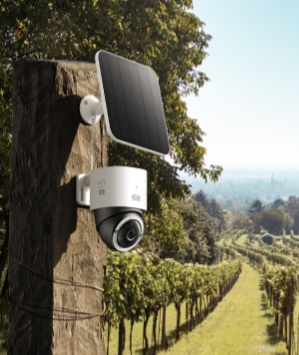How to Troubleshoot 4G Security Camera Issues
4G security cameras have become popular for providing flexible, WiFi-free surveillance, especially in remote areas. However, as with any technology, users may encounter issues that can compromise their camera's performance and reliability. Troubleshooting these issues effectively ensures continuous security coverage and optimal functionality. Whether it's connectivity, power, storage, or remote access, knowing how to address these problems can save time and protect valuable footage. With security cameras without wifi like eufy, you can achieve off-grid security that leverages mobile data. But it's essential to identify and address any recurring issues promptly to maximize their reliability and performance.

Checking Signal Strength and Network Connectivity
A strong 4G connection is vital for a 4G security camera's performance. Poor signal strength can lead to delayed notifications, interrupted video feeds, or even complete disconnections. Understanding how to check and improve network strength can be essential for optimal camera operation.
Relocating the Camera for Better Signal
Camera placement plays a significant role in maintaining a stable 4G connection. If your camera is installed in an area with obstacles such as trees or walls, the signal strength may be compromised. Start by evaluating the current location and consider moving the camera to a higher or more open position. Avoid placing it in low-lying areas or too close to metal objects, as these can interfere with signal transmission. For example, if your camera is installed near dense foliage or other physical obstructions, relocating it to an open area can help improve reception. Adjusting the height can make a noticeable difference, as higher locations often offer fewer obstacles. Also, ensure that the camera is within reach of strong mobile network coverage.
Using Signal Boosters and Antennas
In locations with weak cellular reception, a signal booster or external antenna can make a substantial difference. Signal boosters amplify weak signals, providing a more consistent connection for data transfer. Choose a signal booster compatible with 4G LTE frequencies to ensure seamless performance with your camera. For instance, some 4G cameras, such as eufy models, are compatible with additional external antennas, which can boost the connection in remote locations. External antennas are particularly helpful for cameras placed in hard-to-reach areas, as they extend the coverage and improve connectivity for uninterrupted monitoring.
Troubleshooting Power and Battery Issues
Power reliability is crucial for keeping 4G security cameras operational, especially if they're in remote or off-grid locations. If your camera runs on battery or solar power, keeping an eye on power efficiency and longevity is essential.
Inspecting Battery Health and Charging
Regularly check the battery's health and charging status. If the camera isn't holding a charge, it may be due to extreme temperatures, which can drain batteries more quickly. To keep the camera running effectively, periodically inspect the battery and replace it if it shows signs of wear. Some 4G cameras, like the eufy model with a 9,400 mAh battery, are designed for long-lasting power. However, it's still essential to monitor battery performance, especially if the camera is installed in high-demand areas with continuous recording. When replacing batteries, ensure they are compatible with your camera model, as using the wrong type can damage the device or reduce battery life.
Ensuring Solar Panel Efficiency
For solar-powered 4G cameras, maintaining the solar panel is key to a consistent power supply. Ensure the panel receives enough sunlight daily, avoiding shaded locations. Dirt, dust, or debris on the solar panel surface can also reduce its efficiency. Regularly cleaning the solar panel ensures it can capture maximum energy. If using a camera like eufy's solar-powered model, make sure the panel is angled towards direct sunlight throughout the day. Adjusting the angle seasonally can help capture the optimal amount of sunlight. Additionally, check the panel's wiring to ensure there are no loose connections that could disrupt power flow.

Storage and Video Playback Troubles
Efficient storage management ensures that your camera can capture and retain footage as needed. Common issues include full storage, improperly formatted SD cards, or trouble accessing cloud storage. For SD card issues, make sure the card is properly inserted and correctly formatted to the camera's specifications. Most 4G cameras support specific SD card types and capacities, so double-check compatibility before use. Regularly formatting the SD card also prevents file corruption and maintains optimal storage health. If you're using cloud storage, make sure your 4G connection is stable, as interruptions can lead to incomplete uploads. Some 4G cameras, like eufy, offer cloud storage as an option for seamless remote access to your footage. If you're having trouble accessing cloud storage, verify your camera's cellular connection and update any necessary app settings.
Resolving Remote Access and App Connectivity Problems
Connecting to your 4G camera through a mobile app provides valuable control, but issues such as delayed notifications or connectivity errors can occasionally disrupt this experience. Regular firmware updates and app adjustments are key to resolving these connectivity issues.
Updating Firmware for Improved Connectivity
Firmware updates provide crucial security patches and connectivity improvements. Check your camera's settings to ensure automatic updates are enabled. Regularly updating the firmware ensures compatibility with mobile networks and prevents potential bugs that may disrupt performance. The eufy 4G LTE Cam, for example, benefits from firmware updates that enhance its connectivity features. If your camera's app doesn't support automatic firmware updates, set a reminder to manually check for updates through the app periodically. Keeping the firmware current also helps the device stay compatible with newer cellular network features, which can improve real-time monitoring.
Adjusting App Notifications and Permissions
Sometimes, remote access issues may stem from app permissions or notification settings. Ensure that your mobile app has the necessary permissions enabled for smooth connectivity and instant notifications. In particular, enable background data and location permissions to avoid interruptions. If you're not receiving notifications promptly, check your phone's settings to make sure notifications are active for the security app. Some mobile devices place restrictions on background app usage to conserve battery, which can delay notifications. Adjust these settings as needed to ensure you receive alerts in real-time for security events.
Conclusion
Maintaining a reliable 4G security camera requires attention to connectivity, power, storage, and app functionality. By addressing signal strength, managing power sources effectively, maintaining storage health, and keeping firmware updated, you can ensure optimal performance. 4G security cameras like eufy's models provide a high degree of flexibility and reliability for users in remote locations or areas without WiFi access. Regular maintenance and troubleshooting will ensure that your camera stays operational, protecting your property and providing peace of mind no matter where it's installed. Embrace these best practices to keep your 4G camera running smoothly, ensuring robust, consistent security for the long term.


